Notes For All Chapters Biology Class 11 CBSE
In the previous chapter, you have already learnt that the nervous system in the body, provides point-to-point coordination among the organs. The neural coordination is rapid, but short lived in nature. However, the nerve cells of not reach to each and every cell of the body. So, a special kind of coordination and integration is provided to each cell for continuous cellular functions. This special function is performed by hormones.
Thus, the nervous system and endocrine system are intimately related to each other forming neuroendocrine system together that jointly coordinate together that regulate the physiological functions of the body.
Topic 1 Endocrinology : Major Glands and Their Hormones
Endocrine Glands and Hormones
The endocrine glands are ductless glands, i.e., lack ducts. They pour their secretion into the surrounding blood for transport to the site of action or distandy located target organ. Their secretions are called hormones or internal secretion.
The glands, which have ducts for discharging their secretions onto the body surfaces or into the cavities in the body are called exocrine glands, e.g., Liver, salivary glands, etc.
Hormones
These are non-nutrient chemicals, which are produced in trace amounts and acts as intercellular messengers. These are responsible for regulating the biological processes in the body. The organised endocrine glands also secretes a number of new molecules in addition to the hormones.
Vertebrates have large number of chemicals acting as hormones that provide coordination, while invertebrates possess very simple endocrine systems with few hormones.
Note:
* The first hormone was discovered by William M Bayliss and Earnest H Starling in 1903.
* Endocrinology is the study of endocrine glands and hormones secreted by them.
Human Endocrine System
The endocrine system in humans constitute the endocrine glands and hormone producing diffused tissues/cells located in different parts of our body. In endocrine system, the hormone from one gland may stimulate or inhibit another endocrine gland. These can also vary in structure.
Types of Human Endocrine Glands
The endocrine glands are of following two types in humans
i. Pure Endocrine Glands
It entirely work for the secretion of hormones. They include the hypothalamus, pituitary, pineal, thyroid, adrenal, pancreas, parathyroid, thymus glands and gonads (i.e., testes in males and ovaries in females).
ii. Partial Endocrine Glands
These are pardy endocrine and partly exocrine in function. They includes kidneys, liver, gastro-intestinal tract, heart, placenta, etc.
Structure and Functions of Major Endocrine Glands
Hypothalamus
In humans, the complete endocrine system works more or less under the influence of hypothalamus.
Location
Hypothalamus is located in the basal part of diencephalon (forebrain) regulates a wide spectrum of functions in the body.
Origin
It develops from the ectoderm of embryo like other parts of brain.
with the anterior lobe of pituitary by hypophysial portal blood vessels and to the posterior lobe of pituitary by the axons of its neurons.
Hormones
Hypothalamus contains several groups of neurosecretory cells, known as nuclei, which produce hormones. The function of these hormones is to regulate the synthesis and secretion of pituitary hormones.
Hormones produced by hypothalamus are of following two types
i. Releasing Hormones
These are the hormones that stimulates, the secretion of pituitary hormones, e.g., Gonadotrophin Releasing Hormone (GnRH) which stimulates the gonadotroph cells of anterior pituitary gland to release gonadotrophins.
ii. inhibiting Hormone
These are the hormones that inhibits the release of pituitary hormones, e.g., Somatostatin, which inhibits the secretion of growth hormone from anterior lobe of pituitary gland. All these hormones originating in the hypothalamic neurons, passes through the axons and are released from their nerve endings.
These hormones finally reach the pituitary gland through a portal circulatory system (hypophyseal portal system) thereby, regulating the functions of anterior pituitary. The posterior pituitary however, functions under the direct regulation of the hypothalamus.
Pituitary Gland (Hypophysis)
It is the smallest endocrine gland, but serve very important role in the human endocrine system. It directly or indirectly controls almost all other endocrine glands of the body. It is also known as master gland.
Origin
It originates from the ectoderm of the embryo.
Location and Structure
It is reddish grey in colour and is roughly oval in shape. It is about a size of a pea seed. The pituitary gland is located in a small bony cavity of the brain called sella tursica.
Anatomy
The pituitary gland has three major lobes, i.e., anterior, intermediate and posterior lobe.
It is anatomically divided into two major portions
i. Adenohypophysis
It is the glandular anterior portion of the pituitary gland. It further consists of two parts, i.e., pars distalis and pars intermedia.These two parts represent the anterior and intermediate lobes of pituitary.
a. Pars Distalis
It also called anterior pituitary. It produces different hormones.
These hormones given below with their functions
* Growth Hormone (GH), stimulates the somatotroph cells of anterior lobe of pituitary gland to release its Growth Hormone or somatotrophin. It stimulates body growth, protein, fat and carbohydrate metabolism. Oversecretion of this
hormone during childhood causes gigantism (excessive growth of bones), whereas in adulthood causes acromegaly (abnormal thickness of bones). Its low secretion results in stunted growth, i.e., pituitary dwarfism.
* Prolactin (PRL) The prolactin releasing hormone stimulates lactotroph cells of the anterior lobe of pituitary gland to secrete its prolactin. PRL regulates the growth of mammary glands and formation of milk in them.
* Thyroid Stimulating Hormone (TSH) Thyroid releasing hormone stimulates thyrotroph cells of the anterior lobe of pituitary to secrete its thyroid stimulating hormone, i.e., TSH or thyrotrophin. This TSH stimulate the synthesis and secretion of thyroid hormones from the thyroid gland.
* Adrenocorticotrophic Hormone (ACTH) This is secreted when adrenocorticotrophin releasing hormone (ACRH) stimulates the corticotroph cells of anterior lobe of pituitary. This stimulates the synthesis and secretion of steroid hormones called glucocorticoids from the adrenal cortex.
* Gonadotrophin Hormone It is the gonadotroph cells of anterior lobe of the pituitary gland, which secrete, leuteinizing hormone (LH) and follicle stimulating hormone (FSH). Both of these hormones stimulates the gonadal activity hence, called gonadotrophin.
* Leuteinising Hormone (LH) In males, it stimulates the synthesis and secretion of hormones called androgens from testis. While, in females, it induces ovulation of fully mature follicles (Graafian follicles) and also helps in maintaining the corpus luteum formed from the remnants of the Graafian follicles after ovulation.
* Follicle Stimulating Hormone (FSH) In males, the FSH and androgens together regulate spermatogenesis. In females, this hormone stimulates the growth and development of ovarian follicles.
Details of both hormones (i.e, FSH and LH) and the regulation of different hormones will be studied in class XII.
b. Pars Intermedia or Intermediate Lobe
This portion of adenohypophysis secretes only one hormone,
* Melanocyte Stimulating Hormone (MSH) The melanocyte releasing hormone stimulates the intermediate lobe of pituitary gland to secrete its melanocyte stimulating hormone. MSH acts on melanocytes (melanin containing cells) and regulates the pigmentation of the skin.
Like MSH, another hormone called Melanocyte Inhibiting Hormone (MIH) is also secreted, which inhibits the secretion melanocyte stimulating hormone.
ii. Neurohypophysis
It is a collection of axonal projections from the hypothalamus, which terminates behind the anterior pituitary gland. It is pars nervosa of the neurohypophysis that forms the posterior lobe of pituitary gland.
The posterior pituitary stores and releases two hormones given below
a. Oxytocin
It is a short peptide of nine amino acids, also known as pitocin. It acts on the smooth muscles of our body and stimulates a vigorous contraction of uterus at the time of child birth. It also plays role in ejection of milk from the mammary glands in females.
b. Vasopressin
It is a small peptide hormone, also known as antidiuretic hormone (ADH) or pitressin. This hormone acts mainly at the kidney, stimulating the reabsorption of water and electrolysis by the distal tubules. Thereby reducing the loss of water through urine (diuresis).
Note:
* During the time of parturition (delivery time) in mother, the secretion of oxytocin hormone is at its maximum. It is this hormone only, which causes labour pain at the time of birth. Thus, because of its role, it is called birth hormone and milk ejecting hormone.
* LH is also called ICSH (Interstitial Cell Stimulating Hormone) in males as it affects the interstitial cells or cells of Leydig of testes.
Hormones
It secrete a hormone called melatonin that plays a very important role in the regulation of a 24 hrs (diurnal) rhythm of our body and Melatonin also helps in maintaining the normal rhythms of sleep-wake cycle, body temperature. Metabolism, pigmentation, menstrual cycle as well as our defence capability is also influenced by this hormone.
The melatonin hormone promotes sleep, so it is also known as sleep hormone.
Thyroid Gland
The thyroid gland is known to be the largest endocrine gland.
Origin
It is endodermal in origin, i.e., originates from the endoderm of the embryo. The thyroid gland is bilobed, highly vascular organ.
Location and Structure
It surrounds the front of the larynx and is composed of two lobes. Each of its lobe is located on either side of the trachea in the neck interconnected with each other through a thin flap of connective tissue called isthmus.
It is composed of follicles (round in shape) held together by loose connective tissue called stromal tissues. Each thyroid follicle is composed of follicular cells, enclosing a cavity.
Hormones
The follicular cells synthesise following two hormones
(i) Tetraiodothyronine or thyroxine (T4) hormone
(ii) Triiodothyronine (T3) hormone.
Both these hormones are iodmated forms of the amino acid (tyrosine). They are stored in the colloid that fills the follicles and are released to the blood when needed. Iodine (in diet) is essential for the synthesis of hormone at normal rate in thyroid.
Disorders
i. Hypethysot-nisro
This disorder occurs due to the deficiency of iodine in our diet. It leads to the enlargement of thyroid gland commonly known as goitre.
(а) Hypothyroidism in women at the time of pregnancy affects the development and maturation of the growing baby and leads to stunted growth (cretinism), mental retardation, low intelligence quotient, abnormal skin, deaf-mutism, etc.
(b) Hypothyroidism in adult women may cause irregular menstrual cycle.
ii. tiiypfcitnyroidism
It is the condition during which, rate of synthesis and secretion of thyroid hormones is increased to abnormal high levels. It may occur due to the cancer of the thyroid gland or due to development of nodules of the thyroid gland. It adversly affects the body physiology of an organism.
Note:
* Hashimoto’s disease, an autoimmune disorder in which the thyroid gland is destroyed by autoimmunity. All the functions of thyroid gland gets impaired during this disease.
* Myxoedema It is caused by deficiency of thyroid hormones in adults, it is more common in women and is characterised by puffy appearance due to accumulation of fat in subcutaneous tissue because of low metabolic rate and retarded oxidation.
Functions of Thyroid Hormones
Thyroid hormone serves several function in the body, such as
(i) These hormones regulates and maintains the basal metabolic rate (BMR), i.e., both T3 and
T4 hormones increases the overall metabolic rate of the body.
(ii) They support the process of formation of red blood cells. Also helps in controlling the metabolism of carbohydrates, proteins and fats.
(iii) Influences the maintenance of water and electrolyte in our body. Apart from the hormone T3 and T4, thyroid gland also secretes a protein hormone called thyrocalcitonin (TCT). Its main function is to regulate the level of calcium in blood.
Parathyroid Gland
These are small glands in the human neck that produces parathyroid hormone.
Origin It is endodermal in origin.
Location
These glands are situated on the posterior side of the thyroid gland.
Structure
Parathyroid glands are four in number, i.e., each pair is situated in the two lobes of the thyroid gland on either side.
These are small, flat and oval gland.
Parathyroid glands secretes a single hormone known as parathormone or parathyroid hormone (PTH) (functions opposite to the thyrocalcitonin hormone). The secretion of PTH is regulated by the circulating level of calcium ions in the blood.
Functions of Parathyroid Hormone
Parathyroid hormone serve several functions in the body, such as
(i) It increases the level of Ca2+ levels in the blood.
(ii) It stimulates the process of bone reabsorption (i.e., dissolution/demineralisation) by acting on bones.
(iii) It also stimulates reabsorption of Ca2+ by the renal tubules and absorption of Ca2+ from the digested food.
By the above mentioned functions of parathyroid hormone, it is clear that PTH acts as a hypercalcaemic hormone (increases the level of Ca2+ in the blood). Parathyroids are under the feedback control of blood calcium level. A fall in Ca2+ in blood stimulates them to secrete PTH. Thus, both the hormones (TCT and PTH) play a significant role to control and regulate the concentration of Ca2+ and phosphorus.
Note:
* Parathormone is also known as Collip’s hormone after its discoverer (a Canadian endocrinologist, James B Collips; 1925).
* Hyposecretion of PTH lowers Ca2+ concentration in blood and tissues due to excretion of Ca in urine. This increases the nerve and muscle excitability causing cramps and convulsions. This disorder is known as parathyroid tetany.
* Hypersecretion of PTH draws more Ca2+ from the bones, resulting in their softening, bending and fracture. Osteoporosis is the name given to this condition.
Thymus
It is a lymphoid gland that play an important role in the development of immune system.
Origin
It arises from the endoderm of the embryo.
Structure and Location
The thymus gland is a lobular structure situated on the dorsal side of the heart and the aorta (in the upper part of thorax near the heart). It is a soft, pinkish, bilobed mass of lymphoid tissue and is a prominent gland that gets degenerated with age.
Hormones
The thymus gland secretes peptide hormone called thymosin, which plays a major role in the differentiation of T-lymphocytes, which provides cell-mediated immunity.
Thymosins, when released in the blood has a stimulating effect on the entire immune system. Apart from this thymosin also promotes production of antibodies to provide humoral immunity.
Its degeneration with age occurs due to which production of ‘ thymosin hormone also gets decreased. Thus, resulting in weaker immune response in old people.
Adrenal Gland (Suprarenals)
Location
Our body has a pair of adrenal glands. Each located at the anterior part of each kidney.
Structure
Adrenal glands are conical yellowish bodies composed of two types of tissues.
These are as follows
1. Adrenal Cortex
It is an external firm, pale yellowish tissue derived from mesoderm of embryo.
It is further divided into three concentric layers
(a) Zona Reticularis It is the inner layer of the cortex whose cells are arranged in the net like fashion.
(b) Zona Fasciculata It is the middle layer of the cortex. It is the widest of all three layers.
(c) Zona Glomerulosa It is the outermost layer. It is composed of five layers compactly arranged cells.
Hormones secreted by these three layers of adrenal cortex are collectively known as corticoids.
Three groups of steroid hormones are secreted by adrenal cortex, such as
i. Mineralocorticoids (Aldosterone)
They regulate the balance of water and electrolytes in our body. Aldosterone is the major mineralocorticoid found in our body. It mainly acts on renal tubules stimulating the reabsorption of Na+ and water. Also stimulate the excretion of K+ and phosphate ions from the body.
Its main function is in maintaining electrolytes, body fluid volume, osmotic pressure and blood pressure of the body.
ii. Glucocorticoids (Cortisol)
These are the hormones, which regulate the metabolism of carbohydrates, proteins and fats. Cortisol is the main glucocorticoid found in our body.
(a) Cortisol stimulates the liver for the synthesis of carbohydrates from non-carbohydrate sources (like amino acids and glycerol). This process is known as gluconeogenesis. Hence, glucocorticoids stimulates gluconeogenesis, lipolysis and proteolysis.
(b) Inhibition of cellular uptake and utilisation of amino acids.
(c) Cortisol is involved in the maintenance of cardiovascular system and in proper functioning of kidney.
(d) Cortisol produces anti-inflammatory reactions and also functions in suppression of immune response.
(e) It stimulates the production of RBC.
iii. Sexocorticoids (Androgen)
Adrenal cortex also produces a small quantity of androgenic steroids, i.e., sex hormone (androgens) both in males and females.
These hormones are secreted as DHEA (Dehydroxy epiandrosterone), which acts as a precursor of both testosterone and estrogens.
(a) It play a major role in the growth of axial, pubic and facial hair during puberty.
(b) Development of acne are also due to these hormones in young girl.
(c) It also plays an important role in the development of embryo (foetus).
Note:
* Addison’s disease is caused by deficiency of mineralocorticoids.
* Cushing’s syndrome is due to excess of cortisol, while an excess of aldosterone leads to aldosteronism.
* Adrenal virilism is caused by excess of sex corticoids in a female. In this there is development of male secondary sexual characters such as beard, moustaches, etc in females.
2. Adrenal Medulla
The adrenal medulla lies in the centre of the adrenal gland. It is an internal soft, dark reddish brown tissue derived from the ectoderm.
The adrenal medulla secretes two hormones
(i) Adrenaline (epinephrine)
(ii) Noradrenaline (norepinephrine)
Activation of Adrenaline -no Noradrenaline
Both hormones belong to the category of compounds known as catecholamines and are secreted in response to any kind of stress danger and during emergency situations like fall in blood pressure or sugar level in creased respiratory rate, heart beat, etc.
The CNS at the time of stress or danger stimulates the adrenal medulla to release both these hormones. These are also known as emergency hormones or hormones of fight or flight.
These hormones serves following purposes
(a) Increases, alertness.
(b) Dilation of pupil.
(c) Piloerection (raising of hairs of hands and legs).
(d) Increase in heart beat and rate of respiration.
(e) They also stimulate the breakdown of glycogen due to which the concentration of glucose increases in the blood.
(f) Stimulate breakdown of lipids and proteins.
Pancreas
It is a composite gland that acts as both exocrine and endocrine gland.
Origin
It originates from the endoderm of the embryo.
Location
It lies below the stomach, in the loop of duodenum.
Structure
It is elongated yellowish gland that consists of large number of acini and ducts. Besides these, pancreas consists of 1-2 millions of small group of specialised cells, called Islets of Langerhans (after the name of their discoverer Paul Langerhans in 1869).
In normal human pancreas, these cells represents only 1-2% of the pancreatic tissue.
Each islet consists of major two types of cells as
(i) α-cells (about 25%) It secretes a peptide hormone called glucagon.
(ii) β-cells (about 60%) It secretes a another peptide hormone called insulin.
Note:
Apart from a and P-cetls, Islets of Langerhans consists of two or more types of cells called delta cells or D-cells (about 10%) which secretes somatostatin hormone and PP-cells or F-cells (which secretes pancreatic polypeptide-PP).
Hormones
Glucagon and insulin hive antagonistic effect on blood glucose level. This can be clearedfrom the functioning given below
i. Glucagon
This peptide hormone plays an important role in maintaining the normal blood glucose levels. It brings about change of liver glycogen to blood glucose.
Functions of Glucagon
(a) It acts mainly on liver cells (hepatocytes) and stimulates glycogenolysis, which results in an increased blood sugar known as hyperglycaemia.
(b) Apart from this glucagon also stimulates the process of gluconeogenesis which also contributes to hyperglycaemia. Glucagon is known as hyperglycaemic hormone because it reduces the cellular glucose uptake and utilisation.
(c) It reduces glycogenesis and also enhances lipolysis.
Glucagon also stimulates the secretion of insulin from beta cells by its paracrine effect.
ii. Insulin
This peptide hormone plays a major role in regulation of glucose level in the blood. It mainly acts on hepatocytes and adipocytes (cells of adipose tissue), increasing the cellular glucose uptake and utilisation.
As a result, the movement of glucose takes place rapidly from blood to liver cells and cells of adipose tissues by decreasing the blood glucose level (hypoglycaemia).
Insulin act as a powerful anabolic hormone.
Deficiency Disorder of Insulin
Diabetes mellitus is the common complex disorder caused due to prolonged hyperglycaemia.
This is associated with the loss of glucose (when complete glucose cannot be reabsorbed by the kidneys) in the urine as pancreas fails to release adequate amount of insulin to. lower the level of glucose in the body.
During this disorder, cells fails to utilise glucose and other carbohydrate for production of energy instead start utilising proteins and fats for it (due to which person become weak). Diabetic patients are successfully treated with insulin therapy.
(a) Insulin stimulates the conversion of glucose to glycogen (glycogenesis) in the target cells.
(b) Decreases gluconeogenesis.
(c) Decreases glycogenolysis.
(d) Also reduces the catabolism of proteins and fats.
(e) Increases synthesis of fat in the adipose tissue from fatty acids.
Some Metabolic Conversions
Glycolysis Breakdown of glucose to pyruvic acid.
Glycogenesis Formation of glycogen from glucose.
Glycogenolysis Breakdown of glycogen to glucose.
Gluconeogenesis Conversion of fatty acids or amino acids into sugar.
Lipolysis Breakdown of fats. It forms ketone bodies, which are toxic, Lipogenesis Synthesis of fats.
Ketogenesis Formation of ketone bodies, Deamination Breakdown of amino acids to release ammonia.
Testis
These are the primary sex organ of males. They perform dual role, i.e., function as endocrine gland apart from acting as male sex organ.
Location
A pair of testis is located in the scrotal sac (outside abdomen) of male individuals.
Structure
A testes is composed of many seminiferous tubules which are lined by germinal epithelium and stromal or interstitial tissue.
This epithelium consists of three types of cells
(i) Follicular cells give rise to sperms.
(ii) Interstitial cells or Leydig cells secretes group of hormones called androgens mainly testosterone.
(iii) Sertoli cells provides nourishment to sperms and also secretes hormone (inhibin).
Hormone
Interstitial cells present in the intertubular spaces produces a group of hormones, i.e., androgens. These include testosterone, dihydrotestosterone and androstenedione.But mainly secretes testosterone.
Function
Androgen (mainly testosterone) performs a variety of functions given below
(a) It regulates the development, maturation and functions of male accessory sex organs like epididymis, vas deferens, seminal vesicles, prostate gland, urethra, etc.
(b) These hormones also stimulate changes associated with puberty in males, i.e., muscular growth, growth of facial and axillary hair, aggressiveness, low pitch of voice, etc.
(c) Also stimulates the process of spermatogenesis, i.e., formation of spermatozoa.
(d) Promotes the growth of body tissues such as bones and muscles and helps in the formation of musculine body.
(e) Also have anabolic effects (synthetic effects) on the metabolism of protein and carbohydrate.
Inhibin Hormone
Beside testosterone, another hormone is also secreted from testes by the Sertoli cells, known as inhibin. Its main function is to check and regulate the over activity of testosterone by inhibiting its secretion.
Details about spermatogenesis, male reproductive system and hormones related to it will be studied in higher classes (i.e., class XII).
Ovary
It is the primary sex organ in females that serves to produce ova (female gametes) and female sex hormones.
Location
A pair of ovaries is located in the pelvic cavity (in the abdomen).
Structure
It is an almond-shaped structure. Internally it is composed of ovarian follicles and stromal tissues.
Hormones
Ovary produces two groups of steroid hormones, i.e., estrogen and progesterone. Estrogens are secreted by granulosa cells of Graafian follicle.
After ovulation, the ruptured follicle is converted to another structure called corpus luteum, responsible for secretion of progesterone.
Functions
Both estrogens and progesterone play a vital role in various processes in female. These are as follows
Estrogen
(a) It helps in the growth of uterine endometrium layer during each menstrual cycle.
(b) It directly influences the development of mammary glands.
(c) Regulates female sexual behaviour and stimulate growth and activities of female secondary sex organs.
(d) Plays a role in the development of growing ovarian follicles.
(e) Appearance of female secondary sex characters (deposit of fat on thigh and hip region, high pitch etc.).
Progesterone
(a) It is secreted in very high amount continuously during pregnancy (i.e., supports pregnancy by forming placenta and preventing contractions in uterine wall).
(b) It also acts on mammary glands and stimulates the formation of alveoli (sac-like structures that store milk) and milk secretion.
(c) It also help in forming a mucus plug at cervix.
Relaxin is another hormone secreted by ovary in the later stages of pregnancy. Its main role is in softening ligament, widening pelvic cavity, also affects other ligaments such as of foot etc. Due to which women may experience increase in their foot size during pregnancy.
Topic 2 Endocrinology: Various Tissue Hormones and Mechanism of Hormone Action
We have studied about various endocrine glands of the body and hormones secreted by them till now. However, certain endocrine tissues are not organised to form compact endocrine gland, but are present isolated in the body, i.e., hormones are also secreted by some tissues.
Some examples ofhormones secreted by various tissues are as follows
Hormones of Heart
A very important peptide hormone known as Atrial Natriuretic Factor (ANF) is secreted by the atrial walls of our heart, when blood pressure is increased. Its secretion causes dilation of blood vessels thereby reducing the blood pressure.
Hormones of Kidney
A peptide hormone called erythropoietin is produced by the juxtaglomerular cells of kidney. This hormone stimulates formation of RBC, i.e., erythropoiesis. It is done by activating increased erythropoiesis in haemopoietic tissues.
Hormones of Gastro-intestinal Tract
GI tract develops from the endoderm of the embryo. Endocrine cells that are present in different parts of this and tract secretes four major peptide hormones.
These are as follows
(i) Gastrin, which acts on the gastric glands and stimulates the secretion of hydrochloric acid and pepsinogen.
(ii) Secretin, which acts on the exocrine portion of pancreas (remember pancreas is a mixed gland, performing both exocrine and endocrine roles), stimulating secretion of water and bicarbonate ions.
(iii) Cholecystokinin (CCK) This hormones acts on both pancreas and gall bladder stimulating secretion of pancreatic enzymes and bile juice respectively.
(iv) Gastric Inhibitory Peptide (GIP), which is secreted by intestinal mucosa. Its function is to stop or inhibit the secretion of gastric juice and its motility into stomach.
Apart from all these hormones, several other non-endocrine tissues secrete hormones known as growth factors. These factors are essential for normal growth, repair and regeneration of tissues.
Mechanism of Hormone Action
Hormones are released from their respective gland in very small amount. They carry out widespread effects in the body of an individual. Their response is very specific and accurate. Their effects are produced on target tissues by binding to the specific proteins known as hormone receptors, located in the target tissues only.
Types of Hormones
On the basis of the chemical nature, hormones are divided into following four groups
(i) Peptide, Polypeptide, Protein Hormones (e.g., insulin, glucagon, pituitary hormones, hypothalamic hormones, etc).
(ii) Steroids (e.g., cortisol, testosterone, estradiol and progesterone).
(iii) Iodothyronines (e.g., thyroid hormones).
(iv) Amino acid derivatives (e.g., epinephrine).
Types of Hormone Receptors
Hormone receptors are offblbwing two types
(i) Membrane bound receptors Hormone receptors present on the cell membrane of the target cells.
(ii) Intracellular receptors Hormone receptors present inside the target cell, e.g., Nuclear receptor (present in the nucleus of a cell).
Action of Hormone Through Extracellular Receptor
Hormones that interact with the membrane bound receptors do not enter their target cell in normal condition, but generate secondary messengers such as cyclic AMP (cAMP), IP3 , Ca2+
etc., which regulate cellular metabolism of the body. e.g., Protein or peptide hormone.
Hormones do not participate in a metabolic reaction themselves, they instead acts as messengers only, i.e., primary messengers.
Functioning of Peptide Hormone
Protein hormone is water soluble in nature, binds to the extrinsic receptors (present on cell surface) to form the hormone-receptor complex. The formation of this complex causes the release of enzyme adenylate cyclase. This activated enzyme, thus leads to the formation of CAMP (i.e„ cyclic Adenosine monophosphate) from ATP in the cell from the receptor site.
The hormone receptor complex changes the permeability of the cell membrane to facilitate the passage of materials through it (and thereby, regulates cellular activities of the cell causing specific response to occur).
Generation of second messenger (cyclic AMP or Ca2+) chromosome function by interaction of hormone-receptor complex with the genome, e.g., Steroid hormone, iodothyronines, etc.Functioning of Steroid Hormone
Steroid hormones are lipid soluble in nature, so they can easily diffuse through the cell membrane and bind to receptor molecules present in the cytoplasm to form a hormone-receptor complex that enters the nucleus.
Action of Hormone Through Intracellular Receptors
Hormones that interact with intracellular receptors are mostly involved in the regulation of gene expression .
In nucleus, they bind to specific intracellular receptor site on chromosomes and regulate gene expression that results in physiological responses. Thus, the cumulative biochemical actions result in physiological and developmental effects.
Antagonistic and Synergistic Interactions of Hormones
Hormones can show both antagonistic and synergistic interactions among each other. In antagonistic interactions effects of two hormones are opposite to each other on the target cells, e.g., insulin and glucagon hormones, act antagonistically on blood glucose level.
In synergistic interaction, two or more hormones tend to complement each other for their effect on target cells, e.g., estrogen, progestrone, oxytocin, prolactin all acts synergistically for the secretion, production and ejection of milk in mammary glands.
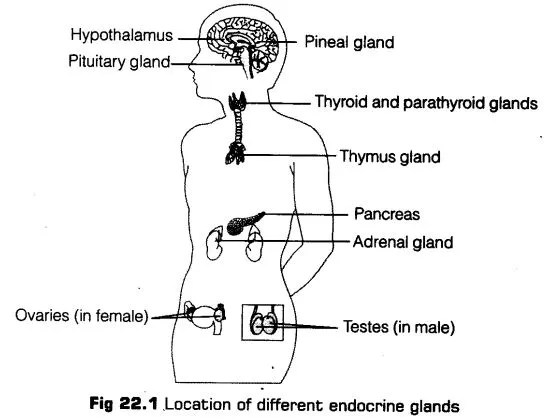
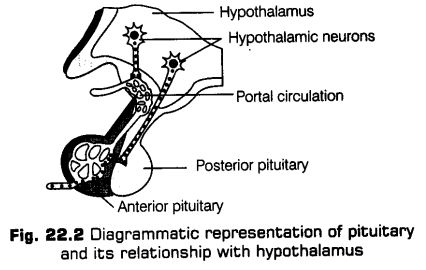
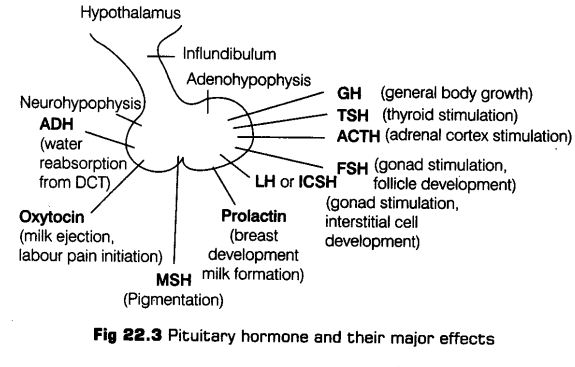
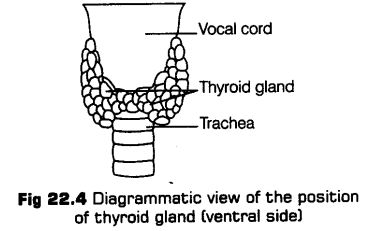
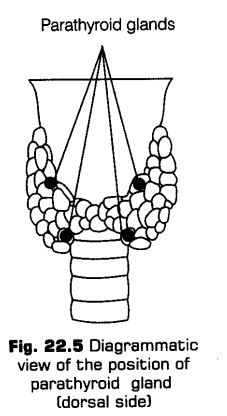
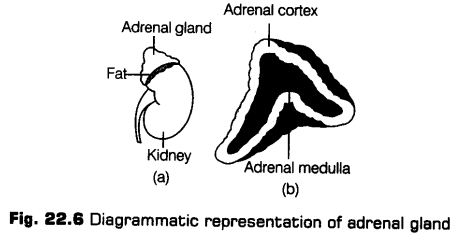

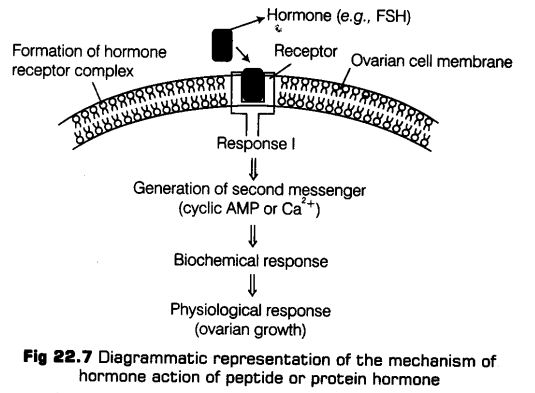
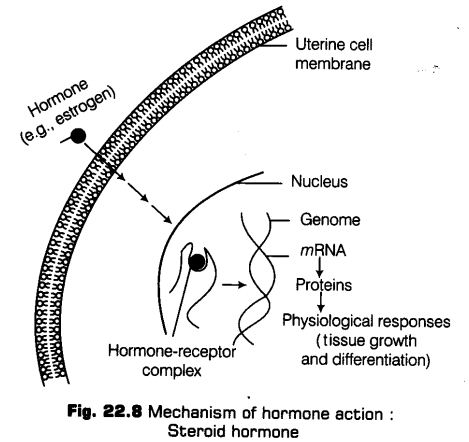

Leave a Reply